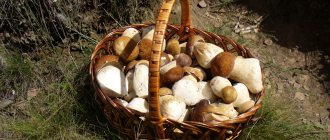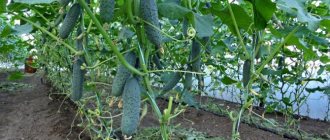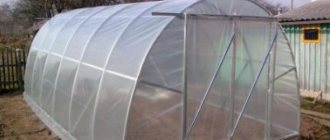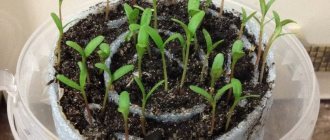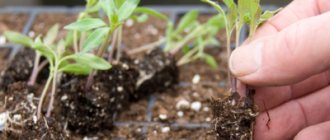Greetings. You know, the answer to the question: “How to grow tomatoes in a greenhouse?” , I have known since childhood. Grandfather and grandmother grew tomatoes both for themselves and for sale. We always had early tomatoes on the table, and this is all because they planted tomatoes in the greenhouse using seedlings.
And I would like to share with you the secrets of an early and rich harvest. Tell you how to properly grow seedlings and their subsequent planting in a greenhouse. I will share family secrets on caring for tomatoes and combating possible difficulties: pests and diseases. And following my recommendations you will grow an early harvest of tomatoes. I suggest studying and implementing.
Why do I grow tomatoes with seedlings in a greenhouse?
I turn to growing tomatoes in greenhouse conditions for a lot of reasons:
- Possibility of harvesting ultra-early and late harvests - from early spring to late autumn.
- Growing tall bushes that do not take root well in open ridges. It is these seedlings that produce large fruits up to 0.5 kg.
- The possibility of planting productive heat-loving varieties that do not do well in harsh Russian conditions.
Greenhouse plants do not require additional care - all activities are simple and familiar, even a beginner can do it.
tall tomatoes in a greenhouse
Stepsoning
For beginners, the biggest difficulty in caring for tomatoes is always rooting. Beginning gardeners are worried that their actions may harm the plants. However, stepsoning is far from the most terrible procedure. It makes it possible to form a beautiful stem without unnecessary branches.
Growing tomatoes in a greenhouse
Stepchildren are side shoots that grow from the leaf axils, and not on the stem. Why are they harmful, why are they removed? The fact is that these branches simply unnecessarily shade the bushes, contribute to the spread of diseases and increase the ripening time of fruits - the tomato has to spend energy growing these essentially unnecessary shoots.
Tomato stepsons
The stepsons are broken off with two fingers; you can leave only the bottom one with one flower brush. These branches are removed when they reach approximately 8 cm in length. The procedure is carried out early in the morning. Tomatoes usually tolerate it well.
As can be seen from the picture, the stepsons grow from the main stem of the plant in the axils of the leaves. And it is best to remove them while they are still small (3-5 cm) - in this case it will be practically painless for the plant
Stepsoning
How to properly plant tomatoes
This, perhaps, is all the wisdom of growing tomatoes in a greenhouse. If you follow all the above recommendations, you are guaranteed to get a good harvest in the first autumn.
When to plant tomatoes in a greenhouse
I determine the readiness of tomatoes for moving by the following criteria:
- Height 20-25 cm.
- 8-12 developed true leaves.
- Formation of 1-2 inflorescences.
- Approximate age: 50-55 days.
I will also introduce you to the approximate dates.
Planting tomatoes by region
Planting seedlings in heated glass greenhouses:
- Northern regions: early May.
- Mid-latitudes: end of April.
- Southern regions: early to mid-April.
Moving to unheated greenhouses:
- Northern regions: second half of May.
- Middle latitudes: first ten days of May.
- Southern regions: end of April.
Planting in light film greenhouses:
- Northern regions: early June.
- Mid-latitudes: end of May.
- Southern regions: early to mid-May.
I advise you to focus on the characteristics of a particular year - cold summer, warm spring, sharp frosts, prolonged thaw, etc.
Planting tomatoes according to the lunar calendar
I will list the favorable dates according to the lunar cycles for 2021:
- in January 2022, you can plant tomatoes on seedlings 2, 14, 17, 18, 20;
- in February 2022, 6 - 9, 11, 12, 14;
- in March it is best to plant tomatoes 7 - 10, 15, 16
- In April, the best planting days for tomatoes are 6, 7, 11 - 12, 17, 18.
- May when to plant tomatoes: 2, 3, 8,9, 15 - 18.
The seedlings planted these days develop strong, healthy, and disease-resistant.
tomato seedlings
Soil preparation
Soil preparation
Every gardener knows about the importance of crop rotation. After all, the right approach to the planting plan allows you to avoid damage by diseases and pests, as well as preserve the fertility of the post .
The best predecessors of tomatoes are: strawberries, carrots, cucumbers, onions, green manure. After them, the yield will increase several times, and the fruits themselves will become much larger. If turnips, beets, and cabbage crops were previously grown in beds with tomatoes, this will also ensure good yields.
It is not worth planting nightshades after potatoes, peppers, eggplants, zucchini, peas, fennel, and various tall vegetables. The harvest from such beds will be insignificant.
Another important factor is ensuring soil quality.
1 Acidity. If you don't know the acidity level of your soil, pH tests can be purchased at any garden department. For neutral soil this indicator is 7. A higher value indicates increased acidity. To grow tomatoes, the soil pH level should be 6-7 units. If the indicator is lower, then lime must be added to the soil at the rate of 0.5-0.8 kg per 1 sq.m.
1 Nutrients. To ensure a large tomato harvest, the soil must contain three important components: nitrogen, potassium and phosphorus. Nitrogen has a beneficial effect on the leaves of the plant. Potassium increases immunity and resistance to disease. Phosphorus strengthens the root system and ensures high-quality fruits. To replenish the lack of nitrogen in the soil, it is recommended to add compost or inorganic substances, potassium - sand, wood ash or granite dust, phosphorus - compost or superphosphates.
1 Compost. This is a natural remedy that not only saturates the soil with nutrients. It also makes the soil structure looser, which has a good effect on the development of the plant’s root system.
It is recommended to add compost in autumn and spring. In the autumn, humus, peat, bird droppings and other organic fertilizers are applied to a depth of 20-25 cm. In the spring - 12-20 cm.
Review of favorite tomato varieties for planting in a greenhouse
Let me introduce the reliably proven varieties of greenhouse tomatoes:
- Major. Indeterminate high-yielding tomato. Fruits with dense pink pulp and a pleasant smell. The variety is resistant to both unfavorable conditions and diseases.
- Miracle of the earth. A high-yielding and early-ripening variety that is very popular among gardeners. The seedlings are tall, the fruits are heart-shaped, very sweet. Some tomatoes can reach a weight of up to 900 g. Plants are resistant to sudden temperature changes and drought.
- Gondola. Mid-season, indeterminate hybrid variety. The fruits weigh 150-500 g. The pulp is red and dense. Tomatoes have excellent keeping quality. They can be eaten fresh, salted, pickled, as part of side dishes and sauces.
- Kohawa. Ultra-early ripening and high-yielding variety. The tomatoes are flat round, weighing up to 150-180 g. The first fruits appear on the 90th day of the plant’s life. The seedlings are resistant to fungal diseases.
- Silhouette. High-yielding mid-early hybrid tomato. The fruits have an unusual rounded-flattened shape with excellent taste. The variety is resistant to unfavorable conditions.
- Dina. Mid-season productive variety. The seedlings are medium-sized, the fruits are round, large (150-200 g), very sweet, interesting bright orange color, rich in keratin. The variety is resistant to diseases and drought.
- Lelya. A recent discovery by breeders is an early ripening and high-yielding tomato. The fruits are small (up to 100 g) with bright red tasty pulp.
- Hurricane. An early-ripening, productive variety. The average weight of tomatoes is 80-90 g. Suitable for consumption fresh, pickled, or processed. The first harvest is harvested 85-90 days after planting.
- Long Keeper. Late high-yielding variety. The plant is of medium height, the fruits are large (up to 300 g), round. Tomatoes ripen well when stored.
- Bull's heart. A variety that has long won recognition among gardeners. Depending on the variety, it produces black, red and yellow fruits weighing up to 300 g, with juicy and fleshy pulp. The plant has record yields.
I never stop at one variety. I prefer to grow ultra-early, mid-ripening and late-ripening ones so that I have delicious tomatoes on my table all summer. When choosing a tomato variety, I focus on the following characteristics: yield, shelf life, ripening time, taste, bush size, approximate weight, fruit size.
tomato varieties
Regular garter tomato
Garter tomato
You should take care of the pegs immediately after planting the seedlings. Depending on the plant variety, the length of the supports can vary from 50 to 100 cm. The pegs should be placed on the north side, 10 cm away from the bush.
It is recommended to garter a tomato for the first time when the fourth or fifth true leaf is formed on the stem. In total, the bushes are tied up about three to four times throughout the entire season. The bushes are fixed with twine or sponge.
Tomatoes should only be tied under branches with fruits. This method provides the plant and crop with the greatest illumination and sufficient heat. In addition, this way the lower tomatoes do not come into contact with the ground and are less susceptible to attacks by pests.
How to grow tomato seedlings correctly
A rich harvest begins with proper seedling preparation. I take care of future plantings by purchasing seeds and breeding seedlings.
Preparing seeds for sowing tomatoes
I approximately sow seeds for seedlings from the beginning of February to the last days of March. The timing varies depending on the type of culture:
- Early. End of March.
- Mid-season. Continuing March.
- Late. End of February.
If you do not want to spend time preparing seed, I recommend purchasing coated seeds that have already been processed by the manufacturer. They are planted in the ground immediately, dry. The rest of the seeds require simple preparation:
- Disinfection in Fitosporin solution for 15 minutes.
- Soak for 15 minutes in a growth stimulator solution. I use sodium humate: ¼ teaspoon per 1 liter of water.
After such simple preparation, the seeds are ready for sowing.
treatment of tomato seeds with Fitosporin-M
Preparing the soil for seedlings
Tomato seedlings do not require special soil - any fertile and loose soil will do. I buy humus and turf soil treated from viruses, fungi and pests at the garden center. You can pay attention to special soil mixtures for nightshades and tomatoes. “Living Earth” and “Tomato and Pepper” soil are popular.
Planting seeds for seedlings is simple:
- Make holes in the bottom of each container to drain excess water and allow air to reach the roots.
- Pour the soil mixture into the prepared cups.
- Make shallow (1-1.5 cm) grooves. If you have prepared the boxes, maintain a distance of 5-7 cm between them with the indentations.
- Spill the soil with heated water.
- Place the seeds in the depressions, cover with soil, and compact the substrate a little with your hands.
- Cover with glass or wrap with cling film.
- Place containers on pallets.
Now you need to move the boxes and glasses to a well-lit, warm place and wait for the first shoots.
Caring for tomato seedlings
The first seedlings appear after 7 days. By the 5th week of development, the gardener makes sure that the plants do not stretch out - this is the time of their increased growth. The seedlings are kept in a well-lit place, the pots are turned 180 degrees every day so that the seedlings do not reach for the light.
The temperature regime is maintained as follows:
- First week. During the day – 16-18 C, at night – 13-15 C.
- Before the dive. During the day – 18-20 C, at night – 15-16 C.
- After the pick. During the day – 20-22 C, at night – 16-18 C.
- Before moving to the greenhouses. During the day – 18-20 C, at night – 15-16 C.
With watering, things are as follows:
- The first watering is when sprouts appear.
- The second – after 7-14 days.
- The third is before the pick.
- After picking - weekly watering.
Use water heated to room temperature, and water the plants at the roots.
After picking, additional feeding is needed:
- A week later. 1 tbsp. spoon of nitrophoska per 10 liters of water. Consumption: 1/2 cup of suspension per 1 bush.
- In 14 days. For 10 liters of water – 1 tbsp. spoon of the drug “Signor Tomato”, 1 tbsp. spoon of superphosphate. Consumption: 1 glass of solution per 1 plant.
- In 2 weeks. For a bucket of water - 1 tbsp. spoon of nitrophoska. For 1 bush – 1 glass of solution.
Fertilizing is carried out after watering. If the soil settles, add more substrate.
Picking tomatoes
If you are propagating seedlings in common boxes, when 2-3 leaves appear, the seedlings are given a pick:
- Take pots with a height and diameter of 8 cm, fill them with the same seedling soil mixture.
- Spill the soil with manganese solution (0.5 g per 1 liter of water).
- Transplant only the strongest and most robust seedlings.
When picking, you can bury seedlings that are too elongated up to the cotyledon leaves.
picking tomatoes
How to pick tomato seedlings: video
How to prepare tomato seedlings for planting in the ground
Already in April - May it is worth starting hardening:
- Open windows in rooms where plants are located. Start with several hours, gradually increasing the ventilation time. At the same time, avoid drafts.
- As soon as the weather gets warm outside, move the plants to the balcony. Start with a 2-hour “walk” and gradually increase the time.
Hardened seedlings acquire a characteristic greenish-purple hue. It should be sent for “walks” pre-watered.
The last preparatory step is pinching 2-3 lower leaf plates. In their place, short “stumps” (2-3 cm) are left. This promotes improved air circulation and good lighting of the plantings.
Growing seedlings
Tomatoes in glasses
To grow your own seedlings, in addition to seeds, you need to acquire seedling containers and soil. To sow seeds, you can use either special peat containers (pots), cassettes, or the simplest plastic cups with drainage holes at the bottom. The soil is suitable for universal sowing or a mixture of sand and peat 1:1.
The seedling container is tightly filled with soil, which is slightly moistened on top. The seeds are planted shallowly and sown not densely, otherwise the seedlings will be weak with thin stems. Immediately after sowing, the containers are covered with film to ensure optimal soil moisture and placed in a warm place where the temperature is kept at 20-23 degrees. After the first shoots appear, the film is removed.
Preparing a greenhouse for planting tomatoes
Before moving tomatoes, you need to properly prepare the greenhouse. I will introduce you to the techniques that I use personally.
How to prepare the soil for planting tomatoes
Traditionally, I replace greenhouse soil once every five years. During this time, it manages to be completely depleted, even if you regularly applied fertilizers.
First thing in the fall, I disinfect the greenhouse substrate using improvised means:
- A solution (1%) of Bordeaux mixture.
- Suspension (1%) of copper sulfate.
- Dolomite flour (50 g per 1 m2).
Then I proceed to the actual preparation of the land:
- I arrange the lower insulating layer - first a 10-centimeter layer of sawdust, dry pine needles or straw. On top is another 10-centimeter layer of rotted compost.
- I fill the insulating bedding with garden soil - it turns out to be a raised ridge 30-40 cm high.
- If the ground is turf, fertilizers are applied during digging (per 1 m2): 3 tbsp. spoons of superphosphate in granules, 1 tbsp. spoon of potassium magnesia, 1 tbsp. spoon of potassium sulfate, 2 tbsp. spoons of ash, 1 teaspoon of urea (replacement - sodium nitrate).
- If the soil is clayey or loamy, an additional bucket (per 1 m2) of peat, humus and crushed sawdust is required.
- If the substrate is peat, additionally add (per 1 m2) 1 bucket of turf, humus, wood shavings or sawdust, and ½ bucket of coarse sand.
After such preparation, the greenhouse is completely ready for the spring transfer of seedlings.
Temperature
Tomatoes can be transplanted into a greenhouse when the temperature is set:
- Priming. Not lower than 13 C at a 10-centimeter depth.
- Air. 20-25 C.
If your greenhouse is heated, these conditions can be created artificially at any time - plant seedlings in early spring and eat fresh tomatoes until late autumn.
Harvest and storage
Harvest ripening times vary depending on:
- climate;
- quality of care;
- varieties of tomatoes;
- sowing time.
The following degrees of ripeness are distinguished:
- green;
- dairy;
- brown (pink);
- red.
The harvest is harvested when the fruits are fully ripe and turn red or reach a brown (pinkish, yellowish) color. In 10-15 days, being in a sunny place, they will mature. Green tomatoes can also ripen, but their taste will be less intense. When only red fruits are collected, the ripening ones become smaller, so it is recommended to additionally remove the pink ones. Harvesting is done every 2-3 days, and when maximum fruiting is achieved - daily. The crop is harvested with stalks.
Milky and pink ripe tomatoes for ripening are placed in conditions of good lighting, with an air temperature of 15 to 20 ° C and a humidity of no more than 80%. At high temperatures, fruits lose their elasticity. The harvest is placed in one layer and kept for one to two weeks until ripening, the room is regularly ventilated.
The average shelf life of fresh harvest is 2-3 months. It can be increased by immersing ripe fruits in heated (up to 60 °C) water for 1.5-2 minutes. Then they are wiped dry, wrapped in paper and placed in boxes or crates, covered with sawdust. Early and mid-season varieties are not stored for long. They are best eaten fresh or frozen and thawed as needed.
How to plant tomato seedlings in a greenhouse step by step
I will present popular schemes for planting tomato seedlings:
- Low-growing and early-ripening, developing into 2-3 stems. Checkerboard arrangement: between rows - 50-55 cm, between plants in one line - 35-40 cm.
- Determinate, standard. Between rows - 40-45 cm, between bushes of the same row - 20 cm.
- Gigantic. They are planted staggered according to the following pattern: between rows - 75-80 cm, between tomatoes of the same row - 55-60 cm.
I plan the transplant itself on a cool, cloudy day. I will present simple step-by-step instructions:
- I make holes 40 cm deep.
- I pour a warm (50-60 C) suspension of potassium permanganate. For 10 liters of water - 1 g of potassium permanganate. One well requires 1-1.5 liters of solution. An alternative is disinfection with Zaslon. You need 250 g of product per 10 liters of water. Consumption per well is 0.5 liters of solution.
- I plant the seedlings with a ball of earth directly into the soil, liquefied by irrigation. If tomatoes were grown in peat cups, I do not remove them.
- I plant low-growing plants straight, overgrown plants at a slight angle.
- I place the tomatoes with already formed inflorescences towards the greenhouse aisle so that they are not shaded by their neighbors.
- I cover each seedling with loose soil and compact it with my palms.
- Finally, you need to add mulch - last year's compost, straw, sawdust, mowed and dried grass.
Some gardeners leave a small hole near each tomato - this is convenient for economical root feeding.
Buying seedlings
Tomato seedlings
If there is no desire or opportunity to grow seedlings, you can buy them. Good planting material can be easily found both in garden centers, from grandmothers at the market or from familiar gardeners.
When purchasing containers with seedlings, you should be guided by the following points:
- Plant stems should be erect and strong.
- The leaves are dark green, without spots or signs of pests.
- Taking flowering seedlings is risky. Planting in a new location can stress the plant, resulting in it not bearing fruit.
Caring for tomatoes after planting
After transplanting, I don’t touch the tomatoes for 5-6 days - I give them time to adapt to unusual conditions. After a week, I carefully loosen the soil around each bush to improve air access to the roots. Then you can begin periodic care.
How to properly water tomatoes in a greenhouse
I want to talk in detail about the features of watering tomatoes:
- This crop requires relatively moderate but frequent watering.
- After each watering, loosening and ventilation are required.
- For water procedures, use water heated under the sun. Pour it into buckets, barrels in the morning, and use it already warm for evening watering.
- It is best to water the plants manually using a hose (at low pressure) or a watering can.
- Tomatoes are watered only at the root. Even the smallest drops of water falling on the leaves can cause sunburn.
Let me present a schedule of water treatments:
- After transplantation, do not water the seedlings for 7-10 days. Otherwise, the development of the root system will be inhibited, and the green part will stretch out.
- Before the fruit starts to set, plants need frequent and abundant watering - once every 5-6 days. One bush needs at least 4-5 liters of water in one sitting. The soil should be well moistened to a depth of 15-20 cm.
- When the first tomatoes appear, watering is increased to once every 3-4 days. However, water consumption is reduced - 3-4 liters per bush is enough.
The fact that the plant is suffering from thirst can be easily understood by the curled upper leaves. And if there is an excess of moisture, even young tomatoes begin to burst.
How to fertilize tomatoes in a greenhouse
Greenhouse tomatoes need 3-4 feedings during the summer season. I traditionally follow this schedule:
- 3 weeks after transplant. For 10 liters of water – 1 tbsp. a spoonful of nitrophoska, 0.5 liters of liquid cow manure. For each bush - 1 liter of solution.
- After 10 days. For 10 liters of water – 1 tbsp. spoon of superphosphate, 1 teaspoon of potassium sulfate. Approximate consumption: ½ bucket of suspension – per 1 m2.
- In 2 weeks. For 10 liters of water - 2 tbsp. spoons of ash, 1 tbsp. spoon of superphosphate. Consumption – 6-8 liters of fertilizer per 1 m2.
- When tomatoes begin to ripen. For 10 liters of water - 2 tbsp. spoons of superphosphate, 1 tbsp. spoon of potassium humate. Approximate consumption is ½ bucket of mixture per 1 m2.
Such complex fertilizing is sufficient for the harmonious development of the plant.
fertilizer for feeding tomatoes
How to grow tomatoes in a greenhouse
As a rule, I carry out the first stepsoning before the seedlings are moved or in the first days after transplantation. I always leave a 2-3 cm “stump” in place of each stepson. This is necessary so that a new process does not begin to develop in its place.
I will present to you the most important rules for growing greenhouse tomatoes:
- Pinch the shoots with your nails and disinfect your hands after each contact with plants to avoid becoming a carrier of infections.
- Plan the procedure in the morning - at this time the stems break off more easily.
- The frequency of stepsoning is 1 time per week.
- After the tomatoes are filled, do not forget to pluck all the lower branches. This is necessary to improve air circulation and prevent fruit rotting.
If you have few seedlings, do not throw away the shoots. Dip their torn ends into water - after a few days the strongest specimens will take root. They can also be planted in a greenhouse and wait for a small harvest.
Ventilation of tomatoes
Gardeners who plant tomatoes in a greenhouse sometimes forget about an important matter - ventilation. The procedure is needed after each watering of the plant. Tomatoes do not tolerate high air humidity. In such unfavorable conditions, the risk of late blight and other fungal infections increases.
I stick to the following temperature regime:
- Initial period of development: day – 20-25 C, night – 16-18 C.
- Formation, ripening of fruits: day – 24-25 C, night – 17-18 C.
The air humidity level should remain stably within 60-65%. Ventilation is especially important when tomatoes are flowering. If condensation forms, the tomatoes will grow tasteless, sour and watery.
How to tie up tomatoes in a greenhouse
When planting seedlings, do not forget to install supports - trellises or pegs - next to each bush. If there are few plants, the latter will be more convenient - use wooden slats, iron rods, and scraps of thin plastic pipes. The peg should be 20-25 cm higher than the plant. For stability, it is driven into the ground at approximately the same distance. The support is installed near the stem, gartering is carried out as necessary.
If you grow tall tomatoes, it is best to install permanent trellises. This will also save space in the greenhouse: it will be possible to plant 3-4 plants per 1 m2. Strong stakes up to 2 m high are driven in between rows. Wire or strong rope is pulled between them every 35-40 cm. Growing tomatoes are passed between the supports, forming a kind of “braid”.
garter pins
Seed preparation
Tomato seeds
The key to good seedlings and high yields is high-quality seeds. Serious manufacturers treat them with special antifungal substances before selling them, which increases the germination of tomatoes.
You can disinfect seeds yourself using a solution of potassium permanganate (1 gram of substance per 1 liter of water). To do this, the seeds are wrapped in a piece of gauze and placed in the prepared liquid for twenty minutes. After the time has passed, the seed should be washed well in cool water and dried.
It is believed that tomato seeds remain viable for nine years. But improper storage conditions and various other factors can significantly shorten this period. If you doubt the quality of the seeds, you can check them in a simple way.
Two to three weeks before sowing, place a couple of seeds in a linen cloth in warm water for a day. Then leave in the same piece of paper in a warm place for 3-4 days. Afterwards, plant the seeds on the ground and watch the seedlings: sprouts have appeared - everything is fine with tomato seeds, there is no greenery - the seeds are not suitable for growing.
You can also select unsuitable seed material visually. Do not leave hollow, too small or large seeds.
To speed up germination, it is recommended to place tomato seeds on a damp cloth and cover with a wet napkin for 18 hours. All this time it is necessary to maintain sufficient humidity.
What difficulties may arise when growing tomatoes in a greenhouse?
Greenhouse tomatoes are sometimes overcome by illnesses and enemies. But both pests and diseases can be successfully resisted using preventive, “therapeutic” methods.
Pest control on tomatoes
Let me introduce you to the most harmful enemies of greenhouse tomatoes:
- Wireworms. To prevent the spread of pests, about a week before moving the tomatoes, build simple traps: make holes around the perimeter, into which you place and bury a “kebab” on a stick - pieces of raw vegetables. After a few days, check the bait and destroy the pests. Wireworms can be found and collected manually by deep digging of the soil. Prevention of pest occurrence - liming, application of mineral fertilizers. When the disease is prevalent, use the insecticide “Bazudin” - according to the instructions, mix the powder with the soil.
- Medvedka. Pest eggs can enter the greenhouse when the soil is replaced. At the initial stages, it can be effectively resisted with folk remedies: infusion of red pepper (150 g per 10 liters of water), vinegar water (2-3 tablespoons per 10 liters) - approximately 0.5 liters of liquid are poured into the pest's burrows. If the problem is serious, turn to insecticides - “Thunder”, “Medvetox”, “Grizzly”.
- Whitefly. Before the tomatoes begin to bloom, the butterfly is effectively combated with Sochva liquid smoke. If the whitefly has completely flooded the greenhouse, spray with a “Phosbecid” suspension - 10 ml per 10 liters of water. Treatment is done before or after sunset. To consolidate the result, spraying is repeated twice more with a break of 15-20 days.
- Caterpillars and cutworm butterflies. Traps - jars of fermenting kvass - are effective against flying specimens. The drink is diluted with water (1:3), a little yeast is added. The caterpillars are collected by hand, and the tomatoes are treated against them with an infusion of wormwood or potato tops. Of the special preparations, “Fitoverm” and “Agravertin” are effective.
I advise you to periodically inspect your plantings for pests. It is easier to destroy them in the initial stages with folk remedies than to use harmful insecticides.
fighting whiteflies in the garden
scoop butterfly
fighting mole crickets in the garden
Prevention of tomato diseases in the greenhouse
Let me introduce the common diseases of greenhouse tomatoes:
- Fomoz (brown rot). Diseases are countered by disinfecting the substrate before planting and avoiding fresh manure and nitrogen fertilizers. Infected stems and fruits are promptly picked off and destroyed. Plants are treated with “Barrier” or “Fundazol”.
- Gray rot. Prevention of the problem is to adhere to the watering schedule. If the disease has made itself felt, the tomatoes are fed with calcium nitrate - 40-50 g per 5 liters of water. You can add phosphorus-potassium fertilizer or a folk remedy - ash solution (250 g of ash per 10 liters of water).
- Apex rot. Prevention of disease - compliance with the correct temperature regime, watering schedule, timely application of calcium supplements.
- Fusarium. You can prevent the disease by carefully handling the seedlings (the disease develops when the roots are damaged), watering with preheated water, and warming up the greenhouse soil before moving the seedlings.
- Mosaic. It is better to dig up and destroy diseased bushes - if they are infected with the virus, they will no longer be productive. Disease prevention is to disinfect seeds before sowing in a 1% manganese solution. They also disinfect seedlings as they grow - 2-3 times with a break of 3 weeks. 1 g of potassium permanganate is diluted in 10 liters of water and used for irrigation.
rot on tomatoes in a greenhouse
Now you know inside and out how to grow healthy and productive tomatoes in a greenhouse. The very first important stage is propagation of seedlings. Don’t forget about preparing the greenhouse for moving seedlings and preventing diseases and pests. Remember that royal harvests are produced only by plants that are well cared for - watered on time and efficiently, fed, tied up and planted.
Poor ovary formation
Modern varieties are high-yielding. Therefore, weak ovary formation indicates a problem. It is usually caused by overheating of plants. To prevent this from happening, the temperature in the indoor building is constantly monitored during the first summer months.
The ovary may not form even if there is insufficient light or improper watering. Another reason may be an excess of fertilizers. The solution is to quickly correct the mistakes made.
To grow tomatoes in a greenhouse, you will have to work hard. But you shouldn’t give in to possible difficulties. The main thing is to carefully read the instructions for the seeds and be patient. If everything is done correctly, in a covered structure the same variety will produce twice as much yield as in open ground.
How to stepchild and is it worth doing?
Pruning tomatoes involves cutting off the side shoots that form in the axils of the leaves. If new shoots are not trimmed in time, they will gain strength and take the lion's share of nutrients. Accordingly, the growing fruits will not have enough nutrition.
How to plant tomatoes
Planting of plants is done according to the following rules:
- Two weeks after planting the seedlings in the greenhouse, the first pinching is carried out.
- Subsequent removal is done systematically once every 7-10 days.
- It is better to remove stepsons by simply breaking them off in the morning. At this time they are more fragile.
- When breaking off, leave a stump of 2-3 cm. Then the shoots will not begin to grow again.
- When the fruits are full, you should pluck the lower branches. This way you will improve air circulation and the vegetables will not rot.
Temperature and humidity
The temperature regime in the greenhouse, which contains previously planted tomato sprouts, must be brought as close to natural as possible. During the day, the temperature should not exceed +28°C, but should not fall below +20°C, and at night it can fluctuate from +15°C to +17°C. Tomatoes love light very much, so they should be illuminated by the sun from morning to evening. Make sure there is no shadow falling on the greenhouse. On a sunny day the temperature should be +25 - +28°C, and on a cloudy day - +20 - +25°C.
To be healthy, plants need optimal temperature and humidity in the greenhouse.
Please note that tomatoes do not tolerate high humidity. For low-growing, as well as for tall varieties of tomatoes, humidity should not exceed 65%.
You have to monitor not only the air temperature, but also the soil temperature. It should fall within the range of +17-22°C. Also, the relative humidity of the soil should not be between 65% and 80% of the total humidity.
Pests and their control
The main enemies of nightshades are aphids, bedbugs, mites, whitefly butterflies, Colorado potato beetles, mole crickets, wireworms, and cutworms.
Tips for protecting tomatoes from insects:
- in the fall, dig up the ground so that the pest larvae freeze out;
- Before sowing, soak the seed in a solution of potassium permanganate;
- calcinate the soil for seedlings;
- in the spring, treat the soil in the greenhouse with insecticides;
- burn last year's tops;
- Plant other nightshade crops away from tomatoes.
TOMATOES: planting, garter, pinching and bush formation, fertilizing
Reviews:
Oksana Khaliullina
writes: What a good dad Yulia has! Thank you for the video. Everything is very clear and understandable!
Zagirovs' estate
writes: And we breed Baikal ourselves, it’s no worse than store-bought and it’s free
Zagirovs' estate
writes: You did the right thing with the tying, it’s better to insert sticks with ropes, we did that too
Natalya Korshunenko
writes: Sergey! Thank you very much for your advice, we use them and everything works out with a bang. For which we are very grateful to you. With all our hearts we wish you success and good luck in everything. Looking forward to the next videos.
Svetlana Shtepa
writes: Thank you! You are great!
The main difference between tomato varieties without limited growth is their early fruits and the highest density of inflorescences on the bush. Many brushes appear on such tomatoes - about fourteen. All tomatoes ripen before the end of the summer season, so this variety is not subject to autumn frosts. Also, tomatoes of unlimited growth are not characterized by late blight disease, which can ruin the entire crop.
Pollination of tomato flowers
In order for greenhouse tomatoes to bear fruit, they must be artificially pollinated - after all, there are no bees in this closed eco-system. That is why during the day, in warm sunny weather, flower brushes need to be gently shaken slightly. And in order for the pollen to germinate on the pistil, after pollination it is advisable to immediately water the soil or sprinkle water (fine spray) on the flowers themselves. And after 2 hours the air humidity will need to be reduced by opening the window and door.
Ventilation itself during the flowering phase of tomatoes is extremely necessary, and it is very important to prevent condensation from forming on the film. After all, waterlogged soil subsequently greatly reduces the content of sugar and dry substances in tomato fruits, which is why they become watery and sour (which is what we usually buy at the market).
That is why watering for growing tomatoes in a greenhouse requires just such a method, thanks to which the harvest will be at its best and the quality of the fruits themselves will not suffer:
- Before the plants bloom, seedlings need to be watered every 5-6 days, 4-5 liters per square meter.
- During flowering, before the start of fruit formation, more abundant watering is needed than before, 10-15 liters per sq.m.
Moreover, the water temperature should always be within 20-22 °C - this is important. And you can water only in the morning, and not at any other time - this is the only way to prevent the formation of excess moisture harmful to tomatoes.





